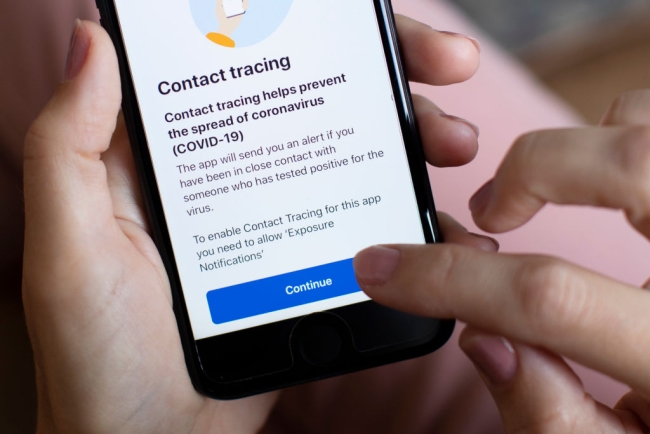You have /5 articles left.
Sign up for a free account or log in.

Dan Kitwood/Getty Images
Contact tracing has been a hallmark of college reopening plans, an essential part of any successful attempt.
But on some campuses, faculty, staff and students have raised concerns that contact tracing at their universities isn’t going far enough.
Specifically, in many cases students and instructors attending in-person class together are not considered “close contacts” for contact tracing purposes. That means a student may sit next to a classmate for three hours per week, but they will not be alerted if that person tests positive for COVID-19.
“Let’s say you’re teaching a class or you’re in a class and someone in your class tests positive in person. You’d imagine contact tracing should talk to everyone in that class, right?” said Alex Wolf-Root, president of United Campus Workers Colorado and an instructor at University of Colorado at Boulder. “They don’t. And the reason they don’t, we’re being told, is, the classrooms are set up where if you’re following the rules, there can’t be spread.”
Wolf-Root is skeptical.
Students and faculty at other universities, including Boston College, Boston University, the University of Kentucky and Vanderbilt University have also raised concerns about who counts as a close contact at their universities.
The Centers for Disease Control and Prevention considers "close contact" to be any interactions where people are within six feet of one another for at least 15 minutes. That leaves out a lot of common interactions. Have a chat at a three-foot distance for 11 minutes? Not close contact. Sit across the room from someone for hours? Doesn’t count.
The scientific discussion on what should be considered close contact does not seem to have reached a firm consensus. For example, England’s public health agency includes the six-foot, 15-minute rule but also says that people who have had skin-to-skin contact with, ridden in cars with, had a sexual encounter with or been coughed on by someone who has tested positive for COVID-19 should be considered close contacts.
Virginia’s public health department has specified that exposure to a person’s respiratory molecules, such as drinking from the same cup, is considered close contact as well.
Though the CDC definition is irrespective of mask wearing, ("the general public has not received training on proper selection and use of respiratory [personal protective equipment]," guidance says), others have differentiated between masked and unmasked contact. Iowa’s public health department has now said that, outside of health-care or residential settings, if an infected person and close contacts were all wearing masks during their interaction, the contacts won’t be required to quarantine.
Some epidemiologists have said they believe extended interactions, such as sitting in a classroom for hours with an infected person, should count as close contact as well.
“Given what we know about the transmission routes of COVID my advice to universities is to consider anyone who has been in a classroom setting with someone who tests positive over the 48 hours following the end of class to be a potentially exposed contact,” Eleanor Murray, professor of epidemiology at Boston University, said via email. “There are likely some potential nuances where larger spaces or shorter classes are less likely to lead to transmission but we really don’t have the evidence to draw any firm lines around what those guidelines should be.”
Growing evidence suggests COVID-19 is an airborne disease, but there is still no definitive answer on exactly how it is spread.
The CDC says that data to inform the definition of close contact remain limited. While not included in its definition, the agency says that the presence of symptoms, the type of interaction (did someone cough in your face?) and the exposure time do still matter and should be taken into account.
“Data are insufficient to precisely define the duration of time that constitutes a prolonged exposure,” the center says on its website. “Recommendations vary on the length of time of exposure, but 15 minutes of close exposure can be used as an operational definition.”
Many colleges have stuck to the six-feet, 15-minutes definition for their contact tracing, while saying they will take other factors into consideration.
“Due to the physically distanced setup and ventilation measures taken for all of our classrooms, as well as mask requirements for all students and employees, students and instructors in class together are not automatically considered close contacts for contact tracing purposes,” a spokesperson for CU Boulder said via email. But, he said, contact tracers are likely to evaluate cases individually and take timing and circumstances into account.
Health officials at Boston University have said that while students and instructors in classrooms don’t automatically count as close contacts, some situations might require tracing outside those parameters.
“There are unique situations that may require additional contact tracing outside the scope of the ‘within six feet for 15 minutes or longer’ definition,” said Hannah Nichols, director of contact tracing at BU. “An example is a student or employee who has been within a confined space for more than eight hours together, with multiple close interactions throughout the day. Another example would be a student and instructor who have hands-on instruction for several hours with multiple close physical interactions.”
Another example of a unique situation, she said, might involve people at an indoor gathering who interact, though the contact may not add up to 15 minutes.
The American Association of University Professors chapter at Vanderbilt has proposed that at the very least, instructors be informed if any students in their classes test positive. A student’s name could be kept private in that instance, the organization has argued.
“It’s the right of instructors to be informed about classroom exposure,” said one professor who wished to remain anonymous. “The balance of science suggests that one of the forms of exposure is through aerosol transmission in closed spaces.”
Many faculty are in high-risk groups for the virus, the professor said, and faculty and graduate students are not part of university surveillance testing.
The CDC has been a controversial voice in public health since the pandemic began due to reported political interference with its findings. Some public health experts have questioned whether colleges should trust its guidance. The agency declined to recommend colleges test students upon arrival to campus, or start mass testing of the asymptomatic population on campus, measures many universities decided to take anyway. As the semester has gone on, some universities have actually expanded their asymptomatic testing programs.
Whether an expanded definition of close contact will go the same way remains to be seen.








